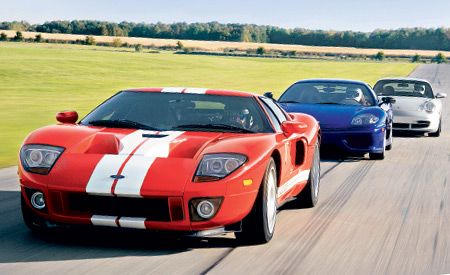Ford GT vs. Ferrari and Porsche test drive

At last, we find out if the highly touted Ford GT can go toe to toe with a fabled Ferrari Challenge Stradale and a killer Porsche 911 GT3. Ford’s GT could be the most overhyped car of the decade. We admit we’re in part to blame, paying tribute with 12 pages in this magazine to date, covering every square inch of the reprised Le Mans champion, every engineering iteration, every development Ford threw our way. We’ve driven early mules with nonspec engines, and unfinished prototypes, but up until now, we’d never strapped our test gear onto the car to find out what we all want to know: How fast is it?
t’s a simple question. Here’s another: How does the $150,000 supercar stack up against the newest European repli-racers, the $101,965 Porsche 911 GT3 and the $193,324 Ferrari Challenge Stradale?
You’re going to find out, but we should explain why we’ve brought these three cars together. First, all of them are meant to give a race-car-like experience in a street vehicle. The race-car theme has been taken to almost ridiculous extremes both to save weight and to provide the perception of saved poundage.
Race cars don’t have sunroofs or navigation systems or satellite radios, and neither do any of these cars. The Ferrari and the Ford have bare floors. Lightweight and extremely cool carbon-fiber panels adorn the insides of the Ferrari’s doors. You won’t find a spare tire in the group.
Even driver aids that wouldn’t add much weight have been left off. Although each car has anti-lock brakes, none has the software and sensors that turn ABS hardware into stability-control systems. Computer bytes weigh nothing. Will the Stradale be that much faster without its optional radio? All these cars have air conditioning, however, despite the pounds it adds. The race-car fantasy would sour quickly if you were sweating all over your date.
Second, each of these cars has a significant racing heritage. The 911 GT3 shares its engine and gearbox with the racing-version GT3 that won its class at Le Mans last year. The Ferrari shares its internal components with two race cars: the 360 GT, which races in the same class as the GT3, and the 360 Challenge, which runs in the single-make Ferrari Challenge series. The Ford GT is a modern interpretation of the GT40 that finished one-two-three at Le Mans in 1966 and went on to win again in ’67, ’68, and ’69.
The third point is that after devoting so much space to describing the GT, it’s high time we put it up against some worthy opponents, and the GT3 and the Stradale are the newest gunslingers on the block. Plus, at about $100,000 for the Porsche and roughly $200,000 for the Ferrari, the Ford GT’s expected base price of $150,000 neatly bisects the two.
Since these are performance cars, we spent most of our time on the 1.9-mile GingerMan Raceway in South Haven, Michigan. We also performed our standard testing regimen, in addition to driving the cars on a very bumpy public-road loop. Along the way to frying three sets of tires, we found a winner.
